Flexible Antibacterial Coatings
Abstract
:1. Introduction
2. Antibacterial Cr–Cu–O Oxide Coatings
2.1. Antibacterial Activity of Cr–Cu–O Coatings
- The number of CFUs of the E. coli bacteria (black dots) decreases with increasing Cu content in the coating and at the surface of the Cr–Cu–O coatings with >15 at.% content of Cu practically all bacteria are killed; here CFU is the colony forming unit.
- Figure 1 shows that (i) no E. coli bacteria are killed on the surface of a pure Si (the surface of Si is fully covered with black dots, i.e., the CFU of E. coli bacteria); (ii) the complete killing of the E. coli bacteria is achieved on the surface of the as-deposited coatings with a high (>15 at.%) Cu content (Figure 1a) and the coatings with 20 at.% Cu content thermally annealed up to ~400 °C (Figure 1b); (iii) the efficiency of bacteria killing (Ek) gradually deteriorates with increasing of the annealing temperature (Ta) and is the lowest at Ta ≈ 650 °C and (iv) the full killing of bacteria is again achieved on the surface of the Cr–Cu–O coating thermally annealed at 700 °C. These changes in the efficiency Ek of E. coli bacteria killing are caused by the variation of the coating structure with annealing temperature Ta (Figure 1b and Figure 2b). The change of Ek with increasing Ta is due to the change of the coating structure from X-ray amorphous at Ta < 550 °C to the following crystalline phases at Ta ≥ 550 °C. The coatings annealed at Ta ranging from 550 °C to 650 °C are multi-phase coatings composed of a mixture of two crystalline CuO and CuCr2O4 oxide phases with admixture of the delafossite CuCrO2 phase at Ta = 650 °C. The CuO and CuCr2O4 phases disappear at Ta = 700 °C when a single-phase Cr–Cu–O coating with the pure delafossite CuCrO2 phase is formed. The evolution of the structure of the Cr–Cu–O coating with increasing Ta is given in [29].
- The efficiency Ek of the E. coli bacteria killing strongly depends on the time of contact of the bacteria with the surface of antibacterial coating. The efficiency Ek increases from 0 to more than 50% during 1 h and reaches ~100% after ~3 h contact of the E. coli bacteria with the surface of the Cr–Cu–O coating with high (≥15 at.%) Cu content (Figure 2a).
- The efficiency Ek of E. coli bacteria killing on the surface of the Cr–Cu–O coating with ≥ 15 at.% Cu content is the same both in the daylight and in the dark at the contact time t = 5 h (Figure 2a,b). It means that no special irradiation, not even daylight irradiation, is necessary to kill E. coli bacteria settled on the surface of the Cr–Cu–O coating.
2.2. Mechanical Properties of Cr–Cu–O Coatings
3. Flexible Antibacterial Coatings
4. Flexible Antibacterial Al–Cu–N and Zr–Cu–N Coatings
4.1. Antibacterial Function
- The efficiency (Ek) of the E. coli bacteria killing on the surface of Al–Cu–N coating increases with increasing Cu content similarly as was found for the Cr–Cu–O coatings. However, there is a substantial difference in the minimum Cu content necessary to kill all bacteria: ~10 at.% Cu for the Al–Cu–N nitride coatings and ~20 at.% Cu for the Cr–Cu–O oxide coatings. It is a result of the replacement of oxygen O with nitrogen N in the antibacterial Me–Cu–X coating.
- The time necessary to kill all E. coli bacteria on the surface of Al–Cu–N coating with 9.6 at.% Cu is about three hours. However, this time is strongly reduced as much as down to one hour when the Cu content in the Al–Cu–N coating is greater than 10 at.% Cu and does not reduce any further when the Cu content is increased. This finding is very important for an industrial design of antibacterial coatings.
- The efficiency Ek of the bacteria killing is the same in the day light and in the dark. It was confirmed by the measurement of Ek in the dark at contact time t = 5 h, see Figure 4.
- Similar results were obtained also for the antibacterial Zr–Cu–N coatings.
4.2. Mechanical Properties
- The hardness H and the effective Young’s modulus E* decrease with increasing Cu content from ~30 GPa to ~17 GPa and from ~260 to ~170 GPa, respectively. Despite this fact, the Zr–Cu–N coatings exhibit high ratio H/E* ≥ 0.1, high elastic recovery We ≥ 60%, and also compressive macrostress (σ < 0) as shown in [38]; thereby they also show an enhanced resistance to cracking for all Cu contents ranging from 0 to 19 at.% Cu. Besides, the hardness H of the Zr–Cu–N coatings ranging from ~25 to ~17 GPa is quite high and it makes possible to prevent the coating from being removed from the surface of a substrate by fretting (wear).
- The efficiency Ek of killing of E. coli bacteria, however, strongly depends on the Cu content. Only the Zr–Cu–N coatings with Cu content ≥10 at.% kill bacteria very efficiently.
- Only the Zr–Cu–N coatings with ≥10 at.% Cu are three-functional-flexible/antibacterial/hard coatings. Similar results were obtained also for the flexible antibacterial hard Al–Cu–N nitride coatings [38].
4.3. Resistance to Cracking
- The Cr–Cu–O coating exhibits low hardness H = 3.2 GPa, low elastic recovery We = 36%, low ratio H/E* = 0.046, and almost zero macrostress σ ≈ 0, which is typical for coatings with a columnar microstructure and a low resistance to cracking in bending and brutal mechanical loading.
- The Al–Cu–N coating exhibits high hardness H = 21.9 GPa, high elastic recovery We = 74%, high ratio H/E* = 0.122, and a compressive macrostress σ = −1.7 GPa, which is typical for coatings with a dense, void-free microstructure and enhanced resistance to cracking.
- The antibacterial Cr–Cu–O coating is brittle. On the other hand, the antibacterial Al–Cu–N coating is flexible.
5. Conclusions
Acknowledgments
Conflicts of Interest
References
- Brook, L.A.; Evans, P.; Foster, H.A.; Pemble, M.E.; Steele, A.; Sheel, D.W.; Yates, H.M. Highly bioactive silver and silver/titania composite films grown by chemical vapour deposition. J. Photochem. Photobiol. A Chem. 2007, 187, 53–63. [Google Scholar] [CrossRef]
- Musil, J.; Louda, M.; Čerstvý, R.; Baroch, P.; Ditta, I.B.; Steele, A.; Foster, H.A. Two-functional direct current sputtered silver-containing titanium dioxide thin films. Nanoscale Res. Lett. 2009, 4, 313–320. [Google Scholar] [CrossRef] [PubMed]
- Foster, H.A.; Sheel, D.W.; Sheel, P.; Evans, P.; Varghese, S.; Rutschke, N.; Yates, H.M. Antimicrobial activity of titania/silver and titania/copper films prepared by CVD. J. Photochem. Photobiol. A Chem. 2010, 216, 283–289. [Google Scholar] [CrossRef]
- Jones, C.M.; Hoek, E.M.V. A review of the antibacterial effects of silver nanomaterials and potential implications for human health and the environment. J. Nanopart. Res. 2010, 12, 1531–1551. [Google Scholar] [CrossRef]
- Foster, H.A.; Ditta, I.B.; Varghese, S.; Steele, A. Photocatalytic disinfection using titanium dioxide: spectrum and mechanism of antimicrobial activity. Appl. Microbial. Biotechnol. 2011, 90, 1847–1868. [Google Scholar] [CrossRef] [PubMed]
- Hsieh, J.H.; Yeh, T.H.; Hung, S.Y.; Chang, S.Y.; Wu, W.; Li, C. Antibacterial and tribological properties of TaN-Cu, TaN-Ag, and TaN-(Ag, Cu) nanocomposite thin films. Mater. Res. Bull. 2012, 47, 2999–3003. [Google Scholar] [CrossRef]
- Hsieh, J.H.; Yeh, T.H.; Li, C.; Chang, S.Y.; Chiu, C.H.; Huang, C.T. Mechanical properties and antibacterial behaviors of TaN-(Ag, Cu) nanocomposite thin films after annealing. Surf. Coat. Technol. 2013, 228, S116–S119. [Google Scholar] [CrossRef]
- Hsieh, J.H.; Chiu, C.H.; Li, C.; Wu, W.; Chang, S.Y. Development of anti-wear and anti-bacteria TaN-(Ag, Cu) thin films—A review. Surf. Coat. Technol. 2013, 233, 159–168. [Google Scholar] [CrossRef]
- Hsieh, J.H.; Yeh, T.H.; Li, C.; Chiu, C.H.; Huang, C.T. Antibacterial properties of TaN–(Ag, Cu) nanocomposite thin films. Vacuum 2013, 87, 160–163. [Google Scholar] [CrossRef]
- Chu, P.K. Surface engineering and modification of biomaterials. Thin Solid Films 2013, 528, 93–105. [Google Scholar] [CrossRef]
- Huang, H.L.; Chang, Y.Y.; Weng, J.C.; Chen, Y.C.; Lai, C.H.; Shieh, T.M. Anti-bacterial performance of zirconia coatings on titanium implants. Thin Solid Films 2013, 528, 151–158. [Google Scholar] [CrossRef]
- Huang, H.L.; Chang, Y.Y.; Chen, Y.C.; Lai, C.H.; Chen, M.Y.C. Cytocompatibility and antibacterial properties of zirconia coatings with different silver content on titanium. Thin Solid Films 2013, 549, 108–116. [Google Scholar] [CrossRef]
- Chen, Y.-H.; Hsu, C.-C.; He, J.-L. Antibacterial silver coating on poly(ethylene terephthalate) fabric by using high power impulse magnetron sputtering. Surf. Coat. Technol. 2013, 232, 868–875. [Google Scholar] [CrossRef]
- Rtimi, S.; Baghriche, O.; Ehiasarian, A.; Bandorf, R.; Kiwi, J. Comparison of HIPIMS sputtered Ag- and Cu-surfaces leading to accelerated bacterial inactivation in the dark. Surf. Coat. Technol. 2014, 250, 14–20. [Google Scholar] [CrossRef]
- Borkow, G.; Gabbay, J. Copper as a biocidal tool. Curr. Med. Chem. 2005, 12, 2163–2175. [Google Scholar] [CrossRef] [PubMed]
- Tian, X.B.; Wang, Z.M.; Yang, S.Q. Antibacterial copper-containing titanium nitride films produced by dual magnetron sputtering. Surf. Coat. Technol. 2007, 201, 8606–8609. [Google Scholar] [CrossRef]
- Kuo, Y.; Lee, J.; Wang, C.; Chang, Y. The effect of Cu content on the microstructures, mechanical and antibacterial properties of Cr-Cu-N nanocomposite coatings deposited by pulsed DC reactive magnetron sputtering. Surf. Coat. Technol. 2007, 202, 854–860. [Google Scholar] [CrossRef]
- Liu, P.C.; Hsieh, J.H.; Li, C.; Chang, Y.K.; Yang, C.C. Dissolution of Cu nanoparticles and antibacterial behaviors of TaN-Cu nanocomposite thin films. Thin Solid Films 2009, 517, 4956–4960. [Google Scholar] [CrossRef]
- Ondok, V.; Musil, J.; Meissner, M.; Čerstvý, R.; Fajfrlík, K. Two-functional DC sputtered Cu-containing TiO2 thin films. J. Photochem. Photobiol. A Chem. 2010, 209, 158–162. [Google Scholar] [CrossRef]
- Chiu, T.W.; Yang, Y.C.; Yeh, A.C.; Wang, Y.P.; Feng, Y.W. Antibacterial property of CrCuO2 thin films prepared by RF magnetron sputtering. In Proceedings of the 11th International Symposium on Sputtering and Plasma Processes (ISSP 2011), Kyoto, Japan, 6–8 July 2011; pp. 495–498. [Google Scholar]
- Chiu, T.W.; Yu, B.S.; Wang, Y.R.; Chen, K.T.; Lin, Y.T. Synthesis of nanosized CuCrO2 porous powders via a self-combustion glycine nitrate process. J. Alloy. Compd. 2011, 509, 2933–2935. [Google Scholar] [CrossRef]
- Chan, Y.-H; Huang, C.-F.; Ou, K.-L.; Peng, P.-W. Mechanical properties and antibacterial activity of copper doped diamond-like carbon films. Surf. Coat. Technol. 2011, 206, 1037–1040. [Google Scholar] [CrossRef]
- Straňák, V.; Wulff, H.; Rebl, H.; Zietz, C.; Arndt, K.; Bogdanowicz, R.; Nebe, B.; Bader, R.; Podbielski, A.; Hubička, Z.; et al. Deposition of thin titanium–copper films with antimicrobial effect by advanced magnetron sputtering methods. Mater. Sci. Eng. C 2011, 31, 1512–1519. [Google Scholar] [CrossRef]
- Osorio-Vargas, P.; Sanjines, R.; Ruales, C.; Castro, C.; Pulgarin, C.; Rengifo-Herrera, A.-J.; Lavanchy, J.-C.; Kiwi, J. Antimicrobial Cu-functionalized surfaces prepared by bipolar asymmetric DC-pulsed magnetron sputtering (DCP). J. Photochem. Photobiol. A Chem. 2011, 220, 70–76. [Google Scholar] [CrossRef]
- Grass, G.; Rensing, C.; Solioz, M. Metallic copper as an antimicrobial surface. Appl. Environ. Microbiol. 2011, 77, 1541–1547. [Google Scholar] [CrossRef] [PubMed]
- Singhal, S.K.; Lal, M.; Lata; Kabi, S.R.; Mathur, R.B. Synthesis of Cu/CNTs nanocomposites for antimicrobial activity. Adv. Nat. Sci. Nanosci. Nanotechnol. 2012, 3, 045011. [Google Scholar] [CrossRef]
- Zhang, X.; Huang, X.; Ma, Y.; Lin, N.; Fan, A.; Tang, B. Bactericidal behaviour of Cu-containing stainless steel surfaces. Appl. Surf. Sci. 2012, 258, 10058–10063. [Google Scholar] [CrossRef]
- Chiu, T.-W.; Yang, Y.-C.; Yeh, A.-C.; Wang, Y.-P.; Feng, Y.-W. Antibacterial property of CuCrO2 thin films prepared by RF magnetron sputtering deposition. Vacuum 2013, 87, 174–177. [Google Scholar] [CrossRef]
- Musil, J.; Blažek, J.; Fajfrlík, K.; Čerstvý, R.; Prokšová, Š. Antibacterial Cr–Cu–O films prepared by reactive magnetron sputtering. Appl. Surf. Sci. 2013, 276, 660–666. [Google Scholar] [CrossRef]
- Hsieh, J.H.; Yeh, T.H.; Chang, S.Y.; Li, C.; Tseng, C.C.; Wu, W. Mechanical and antibacterial behaviors of TaN-Cu nanocomposite thin films after multi-rejuvenation. Surf. Coat. Technol. 2013, 228, S81–S85. [Google Scholar] [CrossRef]
- Chen, N.-H.; Chung, C.-J.; Chiang, C.-C.; Chen, K.-C.; He, J.-L. Antimicrobial and decorative ion-plated copper-containing ceramic coatings. Surf. Coat. Technol. 2013, 236, 29–35. [Google Scholar] [CrossRef]
- Chen, H.-W.; Hsu, K.-C.; Chan, Y.-C.; Duh, J.-G.; Lee, J.-W.; Jang, S.-C.; Chen, G.-J. Antimicrobial properties of Zr-Cu-Al-Ag thin film metallic glass. Thin Solid Films 2014, 561, 98–101. [Google Scholar] [CrossRef]
- Chu, J.P.; Liu, T.-Y.; Li, C.-L.; Wang, C.-H.; Jang, J.S.C.; Chen, M.-J.; Chang, S.-H.; Huang, W.-C. Fabrication and characterization of thin film metallic glasses: Antibacterial property and durability study for medical application. Thin Solid Films 2014, 561, 102–107. [Google Scholar] [CrossRef]
- Musil, J. Hard nanocomposite coatings: Thermal stability, oxidation resistance and toughness. Surf. Coat. Technol. 2012, 207, 50–65. [Google Scholar] [CrossRef]
- Musil, J. Advanced hard nanocomposite coatings with enhanced toughness and resistance to cracking, Chapter 7. In Thin Films and Coatings: Toughening and Toughening Characterization; Zhang, S., Ed.; CRC Press: Boca Raton, FL, USA, 2015; pp. 377–463. [Google Scholar]
- Musil, J. Flexible hard nanocomposite coatings. RSC Adv. 2015, 5, 60482–60496. [Google Scholar] [CrossRef]
- Musil, J.; Blažek, J.; Fajfrlík, K.; Čerstvý, R. Flexible antibacterial Al–Cu–N films. Surf. Coat. Technol. 2015, 264, 114–120. [Google Scholar] [CrossRef]
- Musil, J.; Zítek, M.; Fajfrlík, K.; Čerstvý, R. Flexible antibacterial Zr-Cu-N thin films resistant to cracking. J. Vac. Sci. Technol. A 2016, 34, 021508. [Google Scholar] [CrossRef]
- Kusiak-Nejman, E.; Morawski, A.; Ehiasaraian, A.; Baghriche, O.; Pulgarin, C.; Mielczarski, E.; Mielczarski, J.; Kulik, A.; Kiwi, J. E. coli inactivation by high power impulse magnetron sputtering (HIPIMS) Cu surfaces. J. Phys. Chem. C 2011, 115, 21113–21119. [Google Scholar] [CrossRef]
- Chu, J.H.; Lee, J.; Chang, C.C.; Liou, M.L.; Lee, J.W.; Jang, J.S.C.; Duh, J.G. Antibacterial characteristics in Cu-containing Zr-Based thin film metallic glasses. Surf. Coat. Technol. 2014, 259, 87–93. [Google Scholar] [CrossRef]
- Ritmi, S.; Giannakis, S.; Bensimon, M.; Pulgarin, C.; Sanjines, R.; Kiwi, J. Supported TiO2 films deposited at different energies: Implications of the surface compactness on the catalytic kinetics. Appl. Catal. B Environ. 2016, 191, 42–52. [Google Scholar] [CrossRef]
- Musil, J.; Baroch, P. Discharge in dual magnetron sputtering system. IEEE Trans. Plasma Sci. 2005, 33, 338–339. [Google Scholar] [CrossRef]
- Leyland, A.; Mathews, A. On the significance of the H/E ratio in wear control: A nanocomposite coating approach to optimized tribological behavior. Wear 2000, 246, 1–11. [Google Scholar] [CrossRef]
- Musil, J.; Jirout, J. Toughness of hard nanostructured ceramic thin films. Surf. Coat. Technol. 2007, 201, 5148–5152. [Google Scholar] [CrossRef]
- Tsui, T.Y.; Pharr, G.M.; Oliver, W.C.; Bhatia, C.S.; White, R.L.; Anders, S.; Anders, A.; Brown, I.G. Nanoindentation and nanoscratching of hard carbon coatings for magnetic disks. MRS Proc. 1995, 383. [Google Scholar] [CrossRef]
- Musil, J.; Jaroš, M.; Čerstvý, R.; Haviar, S. Evolution of microstructure and macrostress in sputtered hard Ti(Al, V)N films with increasing energy delivered during their growth by bombarding ions. J. Vac. Sci. Technol. A 2017, 35, 020601. [Google Scholar] [CrossRef]
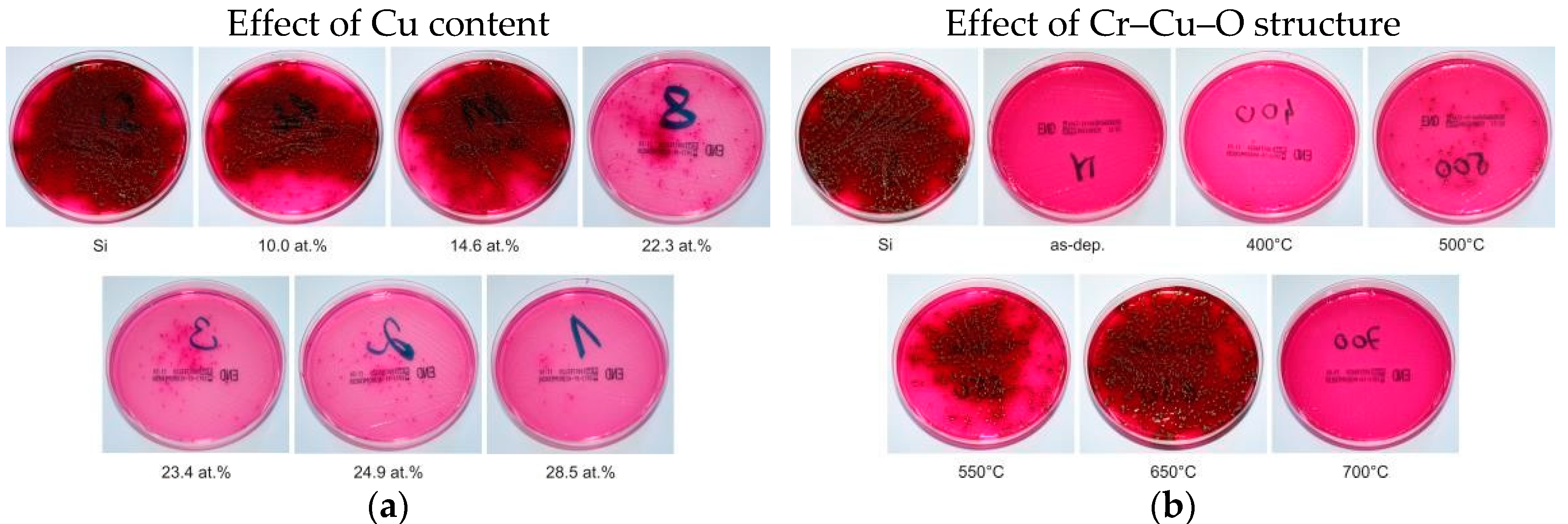
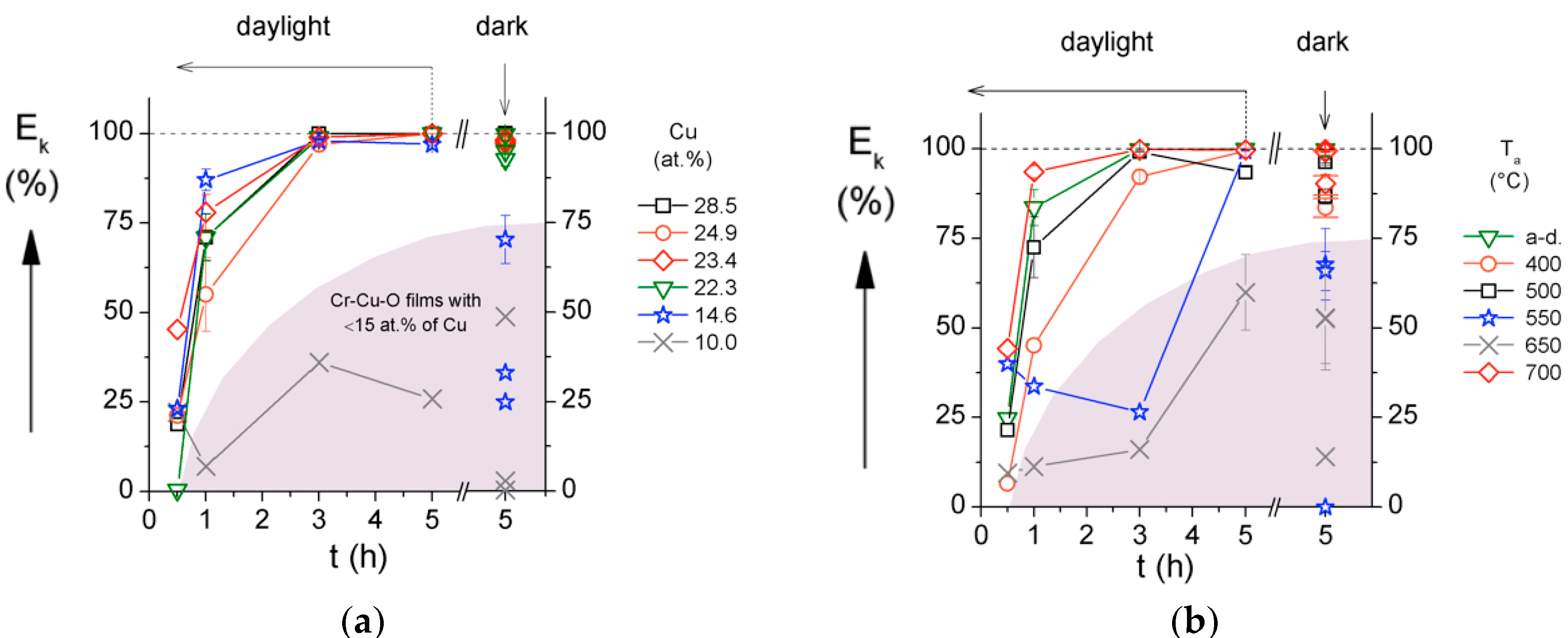
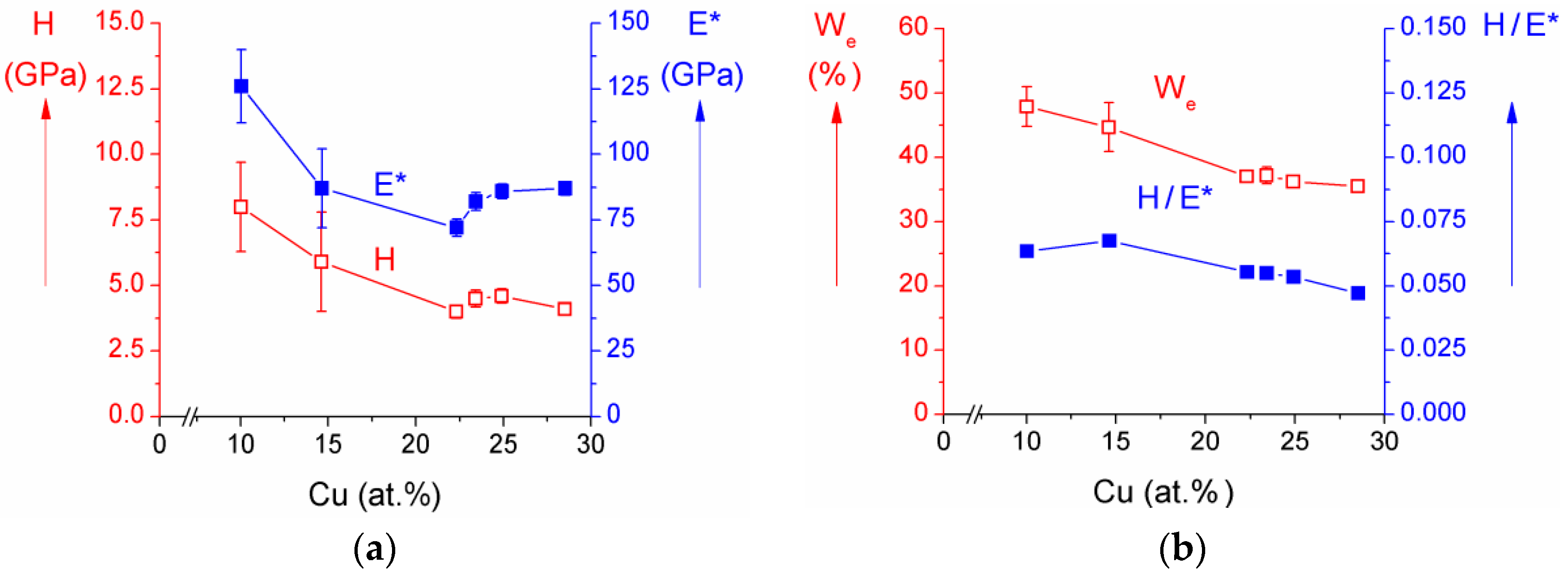
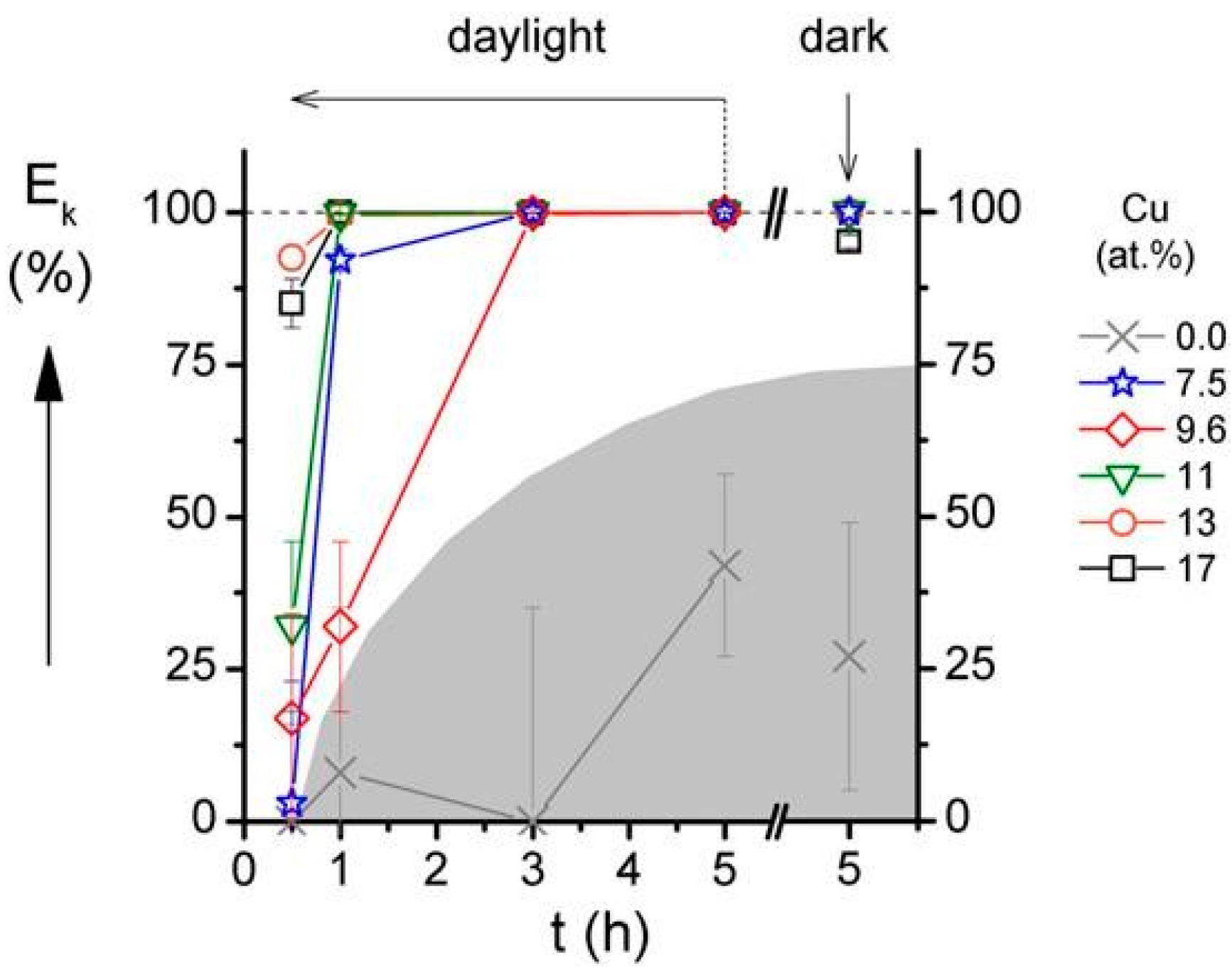
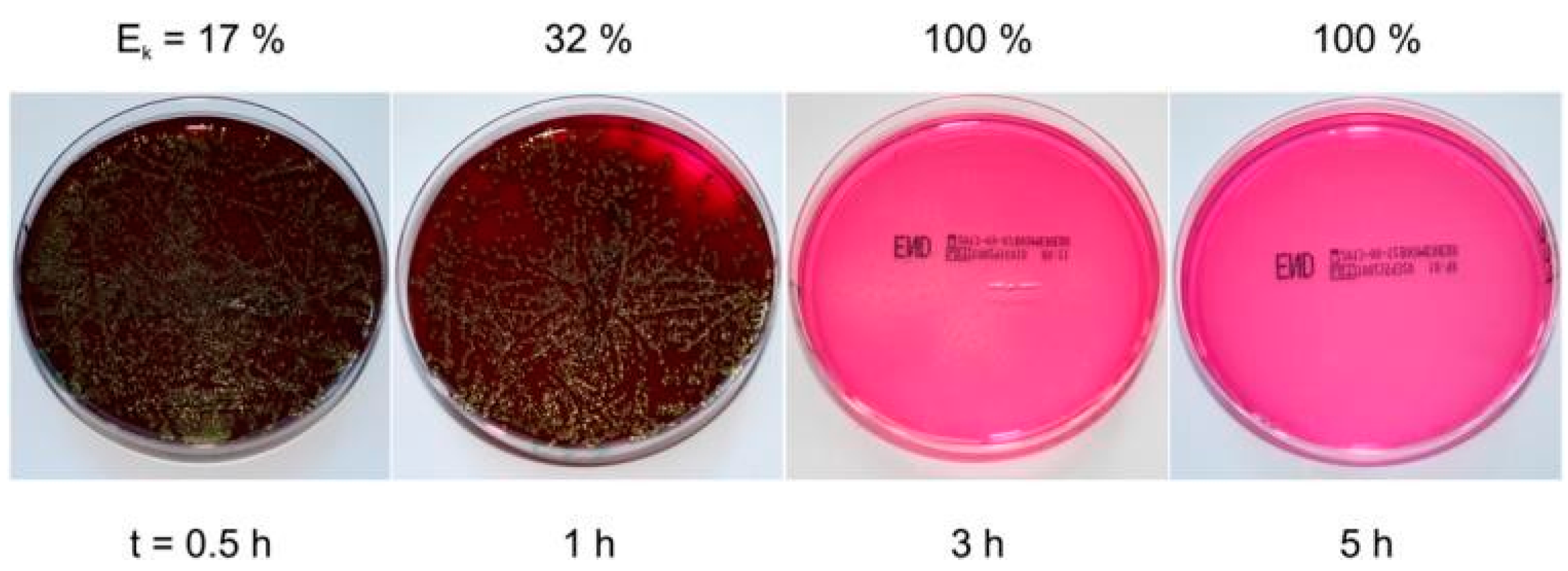

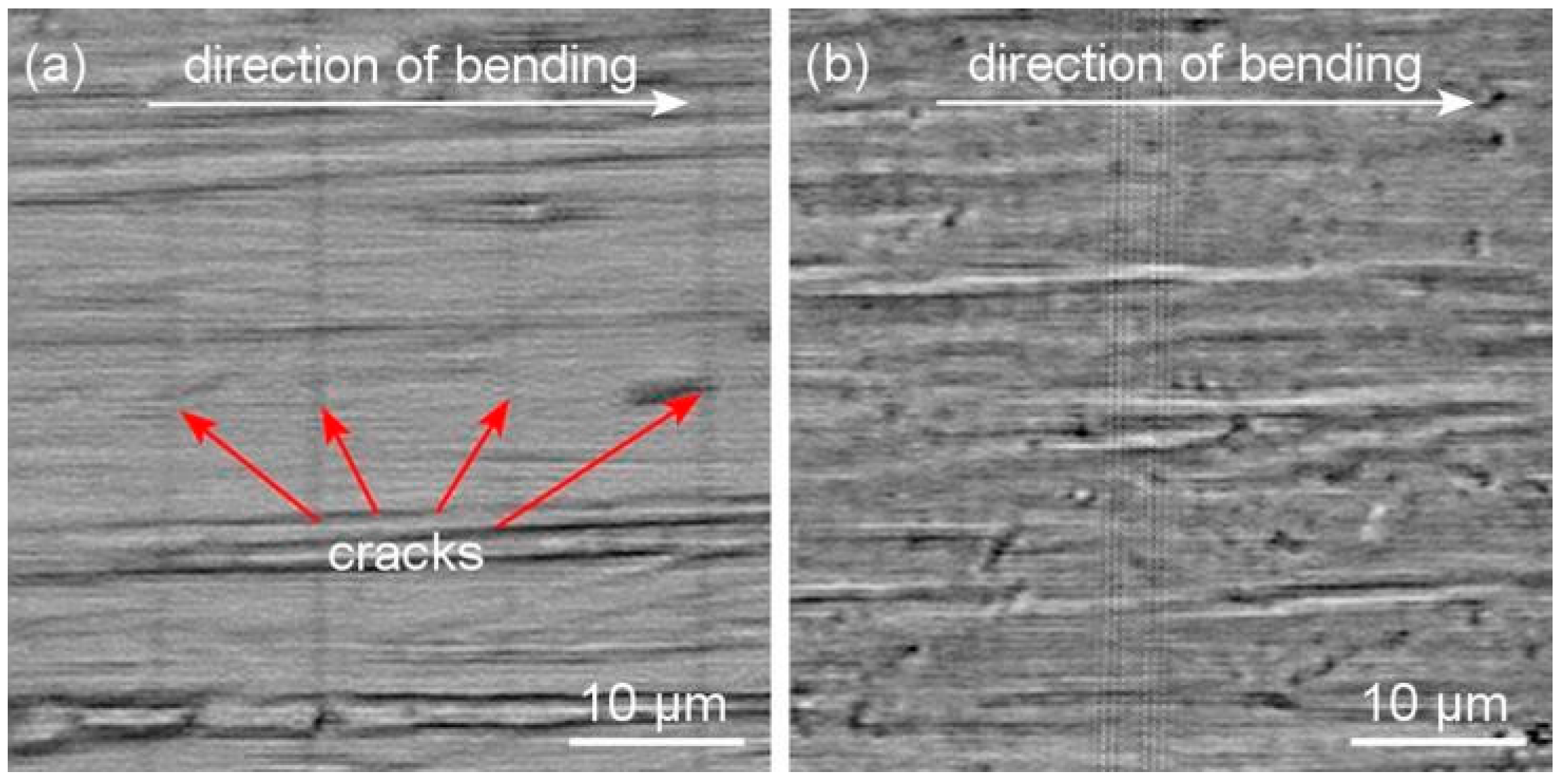
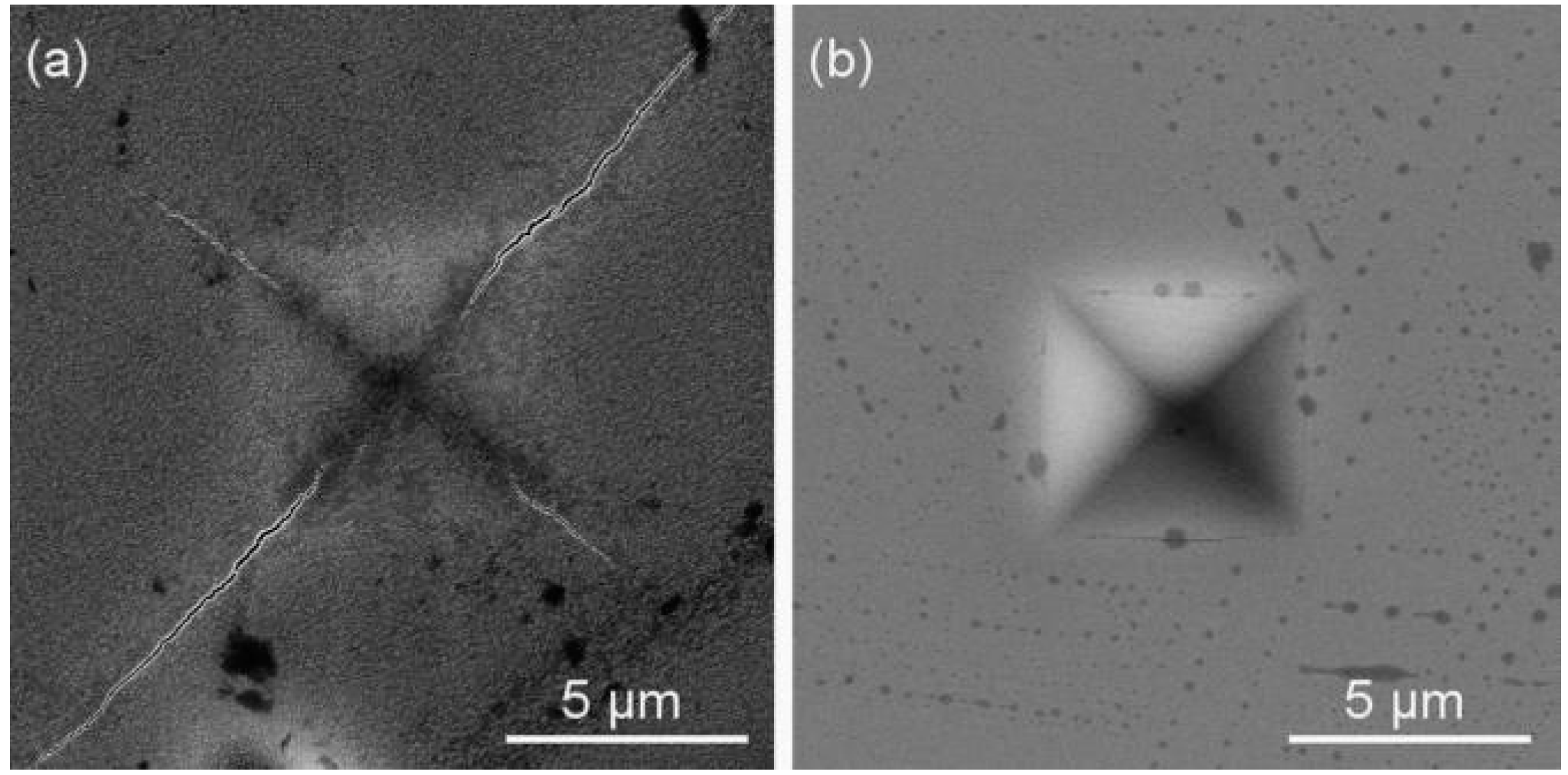
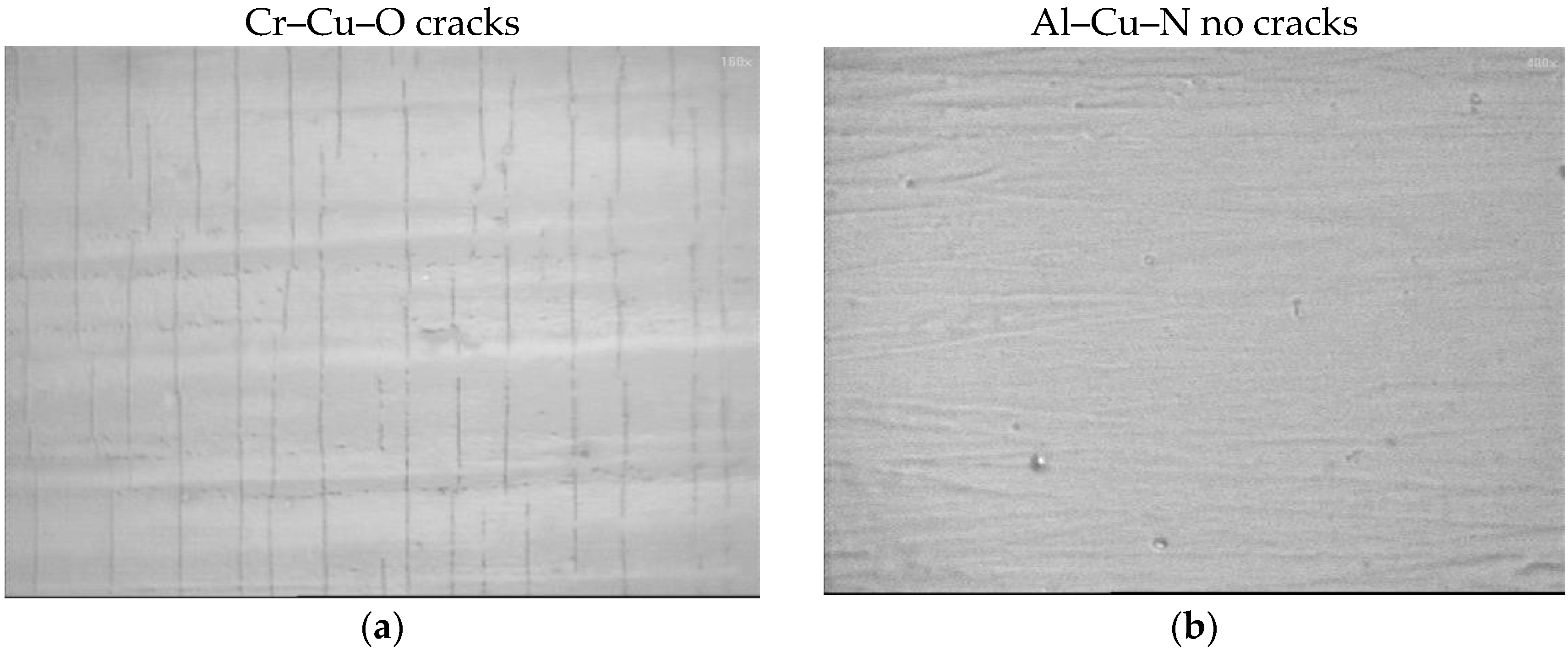
| Coating | Cu (at.%) | H (GPa) | E* (GPa) | We (%) | H/E* | σ | Cracks in Bending |
|---|---|---|---|---|---|---|---|
| Cr–Cu–O | 19.5 | 3.2 | 70 | 36 | 0.046 | 0.1 | yes |
| Al–Cu–N | 9.6 | 21.9 | 180 | 74 | 0.122 | −1.7 | no |
© 2017 by the author. Licensee MDPI, Basel, Switzerland. This article is an open access article distributed under the terms and conditions of the Creative Commons Attribution (CC BY) license (http://creativecommons.org/licenses/by/4.0/).
Share and Cite
Musil, J. Flexible Antibacterial Coatings. Molecules 2017, 22, 813. https://doi.org/10.3390/molecules22050813
Musil J. Flexible Antibacterial Coatings. Molecules. 2017; 22(5):813. https://doi.org/10.3390/molecules22050813
Chicago/Turabian StyleMusil, Jindřich. 2017. "Flexible Antibacterial Coatings" Molecules 22, no. 5: 813. https://doi.org/10.3390/molecules22050813





